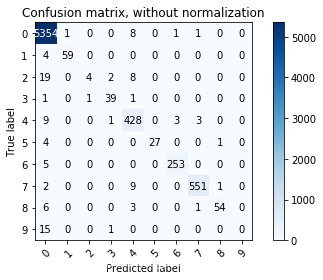这篇教程混淆矩阵可视化写得很实用,希望能帮到您。
混淆矩阵可视化
混淆矩阵的可视化可以让多分类问题变得更加明了,在使用了几个别人写的案例后都不太理想,于是通过官网上的例子进行了一下小小的修改,得到了自己满意的结果。

环境:jupyter Notebook
aa=[[5354,1,0,0,8,0,1,1,0,0],
[4,59,0,0,0,0,0,0,0,0],
[19,0,4,2,8,0,0,0,0,0],
[1,0,1,39,1,0,0,0,0,0],
[9,0,0,1,428,0,3,3,0,0],
[4,0,0,0,0,27,0,0,1,0],
[5,0,0,0,0,0,253,0,0,0],
[2,0,0,0,9,0,0,551,1,0],
[6,0,0,0,3,0,0,1,54,0],
[15,0,0,1,0,0,0,0,0,0]]
def plot_confusion_matrix(cm, classes,
normalize=False,
title=None,
cmap=plt.cm.Blues):
"""
This function prints and plots the confusion matrix.
Normalization can be applied by setting `normalize=True`.
"""
if not title:
if normalize:
title = 'Normalized confusion matrix'
else:
title = 'Confusion matrix, without normalization'
# Compute confusion matrix
# Only use the labels that appear in the data
# classes = classes[unique_labels(y_true, y_pred)]
if normalize:
cm = cm.astype('float') / cm.sum(axis=1)[:, np.newaxis]
print("Normalized confusion matrix")
else:
print('Confusion matrix, without normalization')
print(cm)
fig, ax = plt.subplots()
im = ax.imshow(cm, interpolation='nearest', cmap=cmap)
ax.figure.colorbar(im, ax=ax)
# We want to show all ticks...
ax.set(xticks=np.arange(cm.shape[1]),
yticks=np.arange(cm.shape[0]),
# ... and label them with the respective list entries
xticklabels=classes, yticklabels=classes,
title=title,
ylabel='True label',
xlabel='Predicted label')
# Rotate the tick labels and set their alignment.
plt.setp(ax.get_xticklabels(), rotation=45, ha="right",
rotation_mode="anchor")
# Loop over data dimensions and create text annotations.
fmt = '.2f' if normalize else 'd'
thresh = cm.max() / 2.
for i in range(cm.shape[0]):
for j in range(cm.shape[1]):
ax.text(j, i, format(cm[i, j], fmt),
ha="center", va="center",
color="white" if cm[i, j] > thresh else "black")
fig.tight_layout()
plt.show()
return ax
aa = np.array(aa)
plot_confusion_matrix(aa,classes=range(10))
Python 批量修改文件名
L单目标差分进化算法 |

